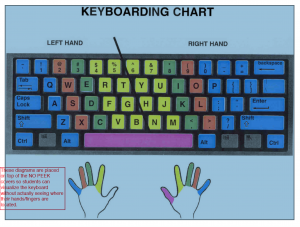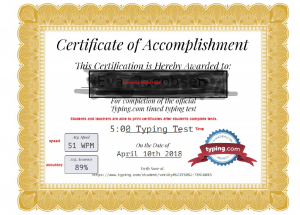Keyboarding & Touch Typing – Amanda Henry
2017 Mini-Grant Recipient
Touch typing (without looking at your hands) involves new terms/concepts such as: home row, keyboard, mouse, speed, accuracy, space bar, index finger, top row, bottom row, Enter, Shift, Tab, Backspace, caps lock, number lock, fonts, and format.
Touch typing also involves correct techniques of workplace ergonomics such as: sitting up straight on the chair, putting all 6 feet on the floor (the student’s 2 feet and chair’s 4 feet), both hands on the key board with fingers resting on the home row keys of ASDF and JKJL. Students position their hands using their index fingers to feel the bumps on F and J, the HOME keys for index fingers. (click on photo to enlarge).


Students attend the typing class for 45 minutes a day for 9 weeks to learn how to touch type with an 80% accuracy at 20 Words Per Minute (WPM). The new program is interactive and engaging, helping students successfully increase their average speed and accuracy to 20 words per minute (WPM) with 89% accuracy. A benefit of the online program is that students can practice at home (especially during snow days or absences), and the teacher can log on and see the progress and times of use. Positive feedback with certificates of accomplishment is a popular outcome.
 Students said they find it easier to complete other assignments after this program taught them how to type more quickly. One said: “This makes typing easier and funner (more fun)”. Other teachers have noted higher student confidence levels in the computer lab.
Students said they find it easier to complete other assignments after this program taught them how to type more quickly. One said: “This makes typing easier and funner (more fun)”. Other teachers have noted higher student confidence levels in the computer lab.
Added licenses cover alternative education students who need a highly modified classroom environment due to behavioral or emotional diversities. These students use the program to improve their skills for better marketability when looking for jobs or trades in their future. Data-entry positions usually require at least 45 WPM, and those for medical transcriptionists, paralegals and secretaries often require anywhere from 70 to 90 WPM on average

